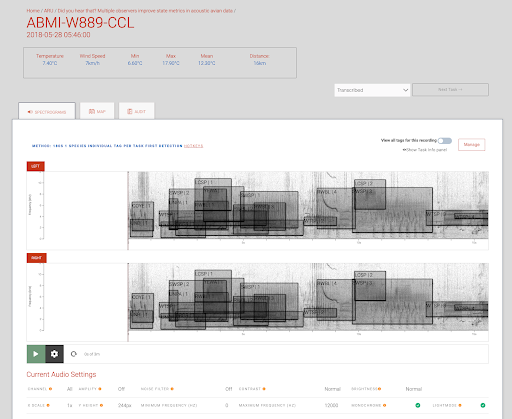What’s all this noise about acoustics?
With support from the Bayne Lab at the University of Alberta, the ABMI has used autonomous recording units (ARUs) and sound technology to monitor the environment for over 10 years. Why ARUs? These robust sensors can be set up and left in the field for months or years, allowing us to easily and passively monitor a wide range of taxa including birds, amphibians, and bats over large periods of time and space. Along the way, we’ve embraced emerging technologies and advancements in artificial intelligence to help advance the field of biodiversity monitoring for all. Our staff have also supported the design and and implementation of bioacoustic monitoring programs in Alberta and beyond.
Through our subsidiary Biodiversity Pathways, we have been able to seek out and help even more individuals and organizations across the country with their ARU programs. Our goal is to facilitate the collection and use of the highest quality acoustic data, data that can then be seamlessly integrated with other datasets to answer more and larger-scale questions about the natural world.
Processing acoustic data
Let’s take a step back: what happens to the recordings collected in the field? Where do they go, and how do we use the data?
“After the recordings are brought in from the field, they go through a rigorous data quality control process,” says Alex MacPhail, our Acoustic Information Manager. “Afterwards, raw audio data is uploaded, managed and stored in WildTrax and ultimately transformed into species detections. A team of trained experts can identify each individual sound and relate it to a species. We select recordings in order to maximize the capture of any species without having to listen to all the recordings from a location. We’re further building tools to allow us to create more reproducible and comprehensive methodologies, including the incorporation of deep learning at the data processing and verification steps.”

Acoustic processing interface in WildTrax
What is WildTrax? WildTrax is a platform for managing, storing, processing, and sharing environmental sensor data. It has been operational for ~5 years and has a large user base of dedicated ARU users across 200 different organizations. All of the ABMI’s data from ARUs and remote cameras is managed and processed using WildTrax.
In addition to WildTrax, a new R package wildRtrax can help advanced users to get even more out of their ARU experience. It contains functions that assist in the pre- and post-processing and analytical workflows normally used in environmental sensor research and analysis. “wildRtrax helps you download your processed data, tidy it, and get it ready for summarization or statistical analysis,” says Elly Knight, our Statistical Ecologist. “And it’s the place you’ll find our advanced analytics products first. We’re currently developing new methods to work with AI-processed acoustic data, estimate distance and density of vocalizing birds, integrate acoustic data with other sensors, and more!”
Attend the wildRtrax webinar on October 25th! It’s free for anyone to attend, but we ask that you register ahead of time so we know who to expect.
What’s next for the acoustics team?
The next phase of WildTrax will be worked on over the fall and winter. Expect lots of amazing changes for ARUs based on our community of users’ requests and needs.
Want to join our team? If acoustics “sounds” like your thing, apply to join our team as an Acoustic Technologist! Put your coding and people skills to work and become part of a growing team dedicated to using environmental sensors and acoustics for biodiversity monitoring.

